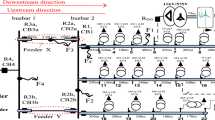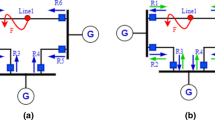Abstract
Photovoltaic (PV) resources’ installation has numerous advantages in distribution feeders nonetheless they may threaten the selectivity and reliability of protective installations. All proposed schemes including employing distance or directional overcurrent relays, mathematics methods, online overcurrent relay settings change, fault current limiters, PV disconnection after fault, computing optimal installation location of PVs, and the others are too costly or complex or inefficient in PV-penetrated feeders. This paper proposes a new central processor unit to create a smart overcurrent relay and prohibit protection blinding, nuisance tripping, unwanted tripping, and synchronous tripping of overcurrent relay in a PV-penetrated distribution feeder. Firstly, the processor consists of four layers of the multi-agent system, which receives information on the relays and sensed current via the grid. Secondly, each agent is responsible to prevent a separate maloperation event and scrutinizing the input information. Finally, it directs the manipulated commend to the respective breaker if relay has acted incorrectly. Overcurrent relays become smart and miscoordination and maloperation problems are corrected completely by implementing the proposed processor. The proposed scheme is fast, offline, inexpensive, independent of the fault and PV installation location, type and impedance of the fault, and PV capacity. The results indicate the proposed plan has acted successfully with 100% efficiency in all scenarios.














































































Similar content being viewed by others
References
Nazir MS, Bilal M, Sohail HM, Liu B, Chen W, Iqbal HMN (2020) Impacts of renewable energy atlas: reaping the benefits of renewables and biodiversity threats. Int J Hydrog Energy 45:22113–22124. https://doi.org/10.1016/j.ijhydene.2020.05.195
Niu H, Wang S, Pan N, Peng Z, Liu X (2021) The influence of grid-connected distributed generation on the power supply reliability of distribution network. J Phys Conf Ser. https://doi.org/10.1088/1742-6596/1920/1/012033
Suresh MCV, Edward JB (2020) A hybrid algorithm based optimal placement of DG units for loss reduction in the distribution system. Appl Soft Comput J 91:106191. https://doi.org/10.1016/j.asoc.2020.106191
Razmjoo A, Gakenia Kaigutha L, Vaziri Rad MA, Marzband M, Davarpanah A, Denai M (2021) A Technical analysis investigating energy sustainability utilizing reliable renewable energy sources to reduce CO2 emissions in a high potential area. Renew Energy 164:46–57. https://doi.org/10.1016/j.renene.2020.09.042
Chen X, Wu X, Lee KY (2021) The mutual benefits of renewables and carbon capture: Achieved by an artificial intelligent scheduling strategy. Energy Convers Manag 233:113856. https://doi.org/10.1016/j.enconman.2021.113856
Patni S, Kumar R, Sharma DP (2021) Numerical simulation of improvement of voltage profile and reliability by efficient placement of distributed generation in grid connected system. SSRN Electron J. https://doi.org/10.2139/ssrn.3818753
Singh B, Gyanish BJ (2018) Impact assessment of DG in distribution systems from minimization of total real power loss viewpoint by using optimal power flow algorithms. Energy Rep 4:407–417. https://doi.org/10.1016/j.egyr.2018.07.003
Meskin M, Domijan A, Grinberg I (2020) Impact of distributed generation on the protection systems of distribution networks: analysis and remedies—review paper. IET Gener Transm Distrib 14:5944–5960. https://doi.org/10.1049/iet-gtd.2019.1652
Sadeghi MH, Dastfan A, Damchi Y (2021) Optimal coordination of directional overcurrent relays in distribution systems with DGs and FCLs considering voltage sag energy index. Electr Power Syst Res 191:106884. https://doi.org/10.1016/j.epsr.2020.106884
Tsimtsios AM, Korres GN, Nikolaidis VC (2019) A pilot-based distance protection scheme for meshed distribution systems with distributed generation. Int J Electr Power Energy Syst 105:454–469. https://doi.org/10.1016/j.ijepes.2018.08.022
El-Arroudi K, Joos G (2018) Performance of interconnection protection based on distance relaying for wind power distributed generation. IEEE Trans Power Deliv 33:620–629. https://doi.org/10.1109/TPWRD.2017.2693292
Ojaghi M, Sudi Z, Faiz J, Member S (2013) Implementation of full adaptive technique to optimal coordination of overcurrent relays. IEEE Trans Power Deliv 28:235–244. https://doi.org/10.1109/TPWRD.2012.2221483
Huchel Ł, Zeineldin HH, Member S (2015) Planning the coordination of directional overcurrent relays for distribution systems considering DG. IEEE Trans Smart Grid 7:1642–1649. https://doi.org/10.1109/TSG.2015.2420711
Radosavljević J, Arsić N, Milovanović M, Ktena A (2020) Optimal placement and sizing of renewable distributed generation using hybrid metaheuristic algorithm. J Modern Power Syst Clean Energy 8:499–510. https://doi.org/10.35833/MPCE.2019.000259
Farh HMH, Al-shaalan AM, Eltamaly AM, Al-shammaa AA (2020) A novel crow search algorithm auto-drive PSO for optimal allocation and sizing of renewable distributed generation. IEEE Access. https://doi.org/10.1109/ACCESS.2020.2968462
Pesaran HAM, Nazari-Heris M, Mohammadi-Ivatloo B, Seyedi H (2020) A hybrid genetic particle swarm optimization for distributed generation allocation in power distribution networks. Energy 209:118218. https://doi.org/10.1016/j.energy.2020.118218
Guillen D, Salas C, Trillaud F, Castro LM, Queiroz AT, Sotelo GG (2020) Impact of resistive superconducting fault current limiter and distributed generation on fault location in distribution networks. Electr Power Syst Res 186:106419. https://doi.org/10.1016/j.epsr.2020.106419
El-Ela AAA, El-Sehiemy RA, Shaheen AM, Ellien AR (2021) Optimal allocation of distributed generation units correlated with fault current limiter sites in distribution systems. IEEE Syst J 15:2148–2155. https://doi.org/10.1109/JSYST.2020.3009028
Guarda FGK, Junior GC, Da Silva CDL (2018) Fault current limiter placement to reduce recloser-fuse miscoordination in electric distribution systems with distributed generation using multiobjective particle swarm optimization. IEEE Lat Am Trans 16:1914–1920. https://doi.org/10.1109/TLA.2018.8447357
NababAlam M (2016) Protection scheme for reconfigurable radial distribution networks in presence of distributed generation. Electr Power Syst Res 3:515–525. https://doi.org/10.1016/j.epsr.2020.106973
Fani B, Hajimohammadi F, Moazzami M, Morshed MJ (2018) An adaptive current limiting strategy to prevent fuse-recloser miscoordination in PV-dominated distribution feeders. Electr Power Syst Res 157:177–186. https://doi.org/10.1016/j.epsr.2017.12.020
Shah PH, Bhalja BR (2014) New adaptive digital relaying scheme to tackle recloser—fuse miscoordination during distributed generation interconnections. IET Gener Transm Distrib 8:682–688. https://doi.org/10.1049/iet-gtd.2013.0222
Varma RK, Member S, Rahman SA, Atodaria V, Mohan S, Member S et al (2016) Technique for fast detection of short circuit current in PV distributed generator. IEEE Power Energy Technol Syst J 3:155–165. https://doi.org/10.1109/JPETS.2016.2592465
Purwar E, Vishwakarma DN, Singh SP (2019) A novel constraints reduction-based optimal relay coordination method considering variable operational status of distribution system with DGs. IEEE Trans Smart Grid 10:889–898. https://doi.org/10.1109/TSG.2017.2754399
Fani B, Bisheh H, Karami-horestani A (2018) An offline penetration-free protection scheme for PV-dominated distribution systems. Electr Power Syst Res 157:1–9. https://doi.org/10.1016/J.EPSR.2017.11.020
Abbaspour E, Fani B, Heydarian-Forushani E (2019) A bi-level multi agent based protection scheme for distribution networks with distributed generation. Int J Electr Power Energy Syst 112:209–220. https://doi.org/10.1016/j.ijepes.2019.05.001
Jia K, Gu C, Xuan Z, Li L, Lin Y (2017) Fault characteristics analysis and line protection design within a large—scale photovoltaic power plant. IEEE Trans Smart Grid 9:4099–4108. https://doi.org/10.1109/TSG.2017.2648879
Patil PS, Badar A, Hinge TP (2021) Application of linear programming for overcurrent protection. In: 2021 Int Conf Intell Technol CONIT 2021:1–4. https://doi.org/10.1109/CONIT51480.2021.9498330.
Ghotbi Maleki M, Mohammadi Chabanloo R, Taheri MR (2019) Mixed-integer linear programming method for coordination of overcurrent and distance relays incorporating overcurrent relays characteristic selection. Int J Electr Power Energy Syst 110:246–257. https://doi.org/10.1016/j.ijepes.2019.03.007
Khond SV, Dhomane GA (2019) Optimum coordination of directional overcurrent relays for combined overhead/cable distribution system with linear programming technique. Prot Control Mod Power Syst. https://doi.org/10.1186/s41601-019-0124-6
Srinivas STP, Shanti SK (2019) A new mixed integer linear programming formulation for protection relay coordination using disjunctive inequalities. IEEE Power Energy Technol Syst J 6:104–112. https://doi.org/10.1109/jpets.2019.2907320
Damchi Y, Dolatabadi M, Mashhadi HR, Sadeh J (2018) MILP approach for optimal coordination of directional overcurrent relays in interconnected power systems. Electr Power Syst Res 158:267–274. https://doi.org/10.1016/j.epsr.2018.01.015
Ghotbi-Maleki M, Mohammadi Chabanloo R, Askarian Abyaneh H, Zamani M (2021) Considering transient short-circuit currents of wind farms in overcurrent relays coordination using binary linear programming. Int J Electr Power Energy Syst 131:107086. https://doi.org/10.1016/j.ijepes.2021.107086
Nascimento JP, Brito NSD, Souza BA (2020) An adaptive overcurrent protection system applied to distribution systems. Comput Electr Eng. https://doi.org/10.1016/j.compeleceng.2019.106545
Rizwan M, Hong L, Waseem M, Ahmad S, Sharaf M, Shafiq M (2020) A robust adaptive overcurrent relay coordination scheme for wind-farm-integrated power systems based on forecasting the wind dynamics for smart energy systems. Appl Sci. https://doi.org/10.3390/APP10186318
Bui DM, Le PD, Nguyen TP, Nguyen H (2021) An adaptive and scalable protection coordination system of overcurrent relays in distributed-generator-integrated distribution networks. Appl Sci. https://doi.org/10.3390/app11188454
Hatefi Torshizi N, Najafi H, Saberi Noghabi A, Sadeh J (2021) An adaptive characteristic for overcurrent relays considering uncertainty in presence of distributed generation. Int J Electr Power Energy Syst 128:106688. https://doi.org/10.1016/j.ijepes.2020.106688
Jain R, Lubkeman D, Lukic S (2018) Dynamic adaptive protection for distribution systems in grid-connected and islanded modes. IEEE Trans Power Deliv 34:281–289. https://doi.org/10.1109/TPWRD.2018.2884705
Alam MN (2018) Adaptive protection coordination scheme using numerical directional overcurrent relays. IEEE Trans Ind Inform 3203:1–10. https://doi.org/10.1109/TII.2018.2834474
Habib HF, Mohamed AAS, El Hariri M, Mohammed OA (2017) Utilizing supercapacitors for resiliency enhancements and adaptive microgrid protection against communication failures. Electr Power Syst Res 145:223–233. https://doi.org/10.1109/IAS.2017.8101884
Sudhakar P, Malaji S, Sarvesh B (2018) Reducing the impact of DG on distribution networks protection with reverse power relay. Mater Today Proc 5:51–57. https://doi.org/10.1016/j.matpr.2017.11.052
Kiani A, Fani B, Shahgholian G (2021) A multi-agent solution to multi-thread protection of DG-dominated distribution networks. Int J Electr Power Energy Syst 130:106921. https://doi.org/10.1016/j.ijepes.2021.106921
dos Reis FB, Pinto JOCP, dos Reis FS, Issicaba D, Rolim JG (2021) Multi-agent dual strategy based adaptive protection for microgrids. Sustain Energy Grids Netw 27:100501. https://doi.org/10.1016/j.segan.2021.100501
Datasheet of sunceco panels. 300 W – 320 W Poly-crystalline Solar Module. Sunceco, Inc
Tekpeti BS, Kang X, Huang X (2018) Fault analysis of solar photovoltaic penetrated distribution systems including overcurrent relays in presence of fluctuations. Int J Electr Power Energy Syst 100:517–530. https://doi.org/10.1016/j.ijepes.2018.03.003
Shih MY, Conde A, Leonowicz Z, Martirano L (2017) An adaptive overcurrent coordination scheme to improve relay sensitivity and overcome drawbacks due to distributed generation in smart grids. IEEE Trans Ind Appl 53:5217–5228. https://doi.org/10.1109/TIA.2017.2717880
Ates Y, Uzunoglu M, Karakas A, Boynuegri AR, Nadar A, Dag B (2016) Implementation of adaptive relay coordination in distribution systems including distributed generation. J Clean Prod 112:2697–2705. https://doi.org/10.1016/j.jclepro.2015.10.066
Najafabadi SRK, Fani B, Sadeghkhani I (2022) Optimal determination of photovoltaic penetration level considering. IEEE Syst J 16(2):2121–2124. https://doi.org/10.1109/JSYST.2021.3052527
Alam MN, Chakrabarti S, Tiwari VK (2020) Protection coordination with high penetration of solar power to distribution networks, In: 2020 2nd Int conf smart power internet energy syst. SPIES 2020, pp 132–137, https://doi.org/10.1109/SPIES48661.2020.9243146
Author information
Authors and Affiliations
Corresponding author
Additional information
Publisher's Note
Springer Nature remains neutral with regard to jurisdictional claims in published maps and institutional affiliations.
Appendix
Appendix
The solar cell circuit model is expressed in this section. Figure
79 indicates the single-diode model for solar cells. The parameters of Table 4 are implemented to the technical characteristics of this model.
By writing a KCL in the circuit:
where \(I\) is the output current of the cell, \(I_{g}\) is the photocurrent, \(I_{d}\) is the diode current, and \(I_{{{\text{sh}}}}\) is the shunt resistor current, which is calculated by Eq. 25:
Also, the diode current can be calculated by Eq. (26):
By writing a KVL in Fig. 79:
where \(I_{{{\text{sat}}}}\) is the saturation current of the diode, n is the ideal coefficient of the diode, K is the Boltzmann factor, and T is the environment temperature in kelvin in Eq. 26, which temperature and irradiation of solar panel are controlled by their normal PDF specifically, as shown in Fig.
80:
By interpreting the above equations in Eq. 24, the output current of each cell is calculated by Eq. 28:
Rights and permissions
Springer Nature or its licensor (e.g. a society or other partner) holds exclusive rights to this article under a publishing agreement with the author(s) or other rightsholder(s); author self-archiving of the accepted manuscript version of this article is solely governed by the terms of such publishing agreement and applicable law.
About this article
Cite this article
Bamshad, A., Ghaffarzadeh, N. A novel smart overcurrent protection scheme for renewables-dominated distribution feeders based on quadratic-level multi-agent system (Q-MAS). Electr Eng 105, 1497–1539 (2023). https://doi.org/10.1007/s00202-023-01741-6
Received:
Accepted:
Published:
Issue Date:
DOI: https://doi.org/10.1007/s00202-023-01741-6






